#sulawesi
Explore tagged Tumblr posts
Text
"The coral reefs of south Sulawesi are some of the most diverse, colorful and vibrant in the world. At least, they used to be, until they were decimated by dynamite fishing in the 1990s.
As part of a team of coral reef ecologists based in Indonesia and the UK, we study the reefs around Pulau Bontosua, a small Indonesian island in south Sulawesi...
In many places around the world, damage like this might be described as irreparable. But at Pulau Bontosua, the story is different. Here, efforts by the Mars coral restoration program have brought back the coral and important ecosystem functions, as outlined by our new study, published in Current Biology. We found that within just four years, restored reefs grow at the same rate as nearby healthy reefs.
Speedy recovery
The transplanted corals grow remarkably quickly. Within a year, fragments have developed into proper colonies. After two years, they interlock branches with their neighbors. After just four years, they completely overgrow the reef star structures and restoration sites are barely distinguishable from nearby healthy reefs.
The combined growth of many corals generates a complex limestone (calcium carbonate) framework. This provides a habitat for marine life and protects nearby shorelines from storm damage by absorbing up to 97% of coastal wave energy.
We measured the overall growth of the reef framework by calculating its carbonate budget. That's the balance between limestone production (by calcifying corals and coralline algae) and erosion (by grazing sea urchins and fishes, for example). A healthy reef produces up to 20kg of reef structure per square meter per year, while a degraded reef is shrinking rather than growing as erosion exceeds limestone production. Therefore, overall reef growth gives an indication of reef health.
At Pulau Bontosua, our survey data shows that in the years following restoration, coral cover, coral colony sizes, and carbonate production rates tripled. Within four years, restored reefs were growing at the same speed as healthy reefs, and thereby provided the same important ecosystem functions...
Outcomes of any reef restoration project will depend on environmental conditions, natural coral larvae supply, restoration techniques and the effort invested in maintaining the project. This Indonesian project shows that when conditions are right and efforts are well placed, success is possible. Hopefully, this inspires further global efforts to restore functioning coral reefs and to recreate a climate in which they can thrive."
-via Phys.org, March 11, 2024
#coral#coral reef#marine life#marine biology#sea creatures#aquatic#environment#ecology#environmental news#environmental science#climate action#climate hope#ecosystem#conservation#endangered species#indonesia#sulawesi#good news#hope#overfishing#hopepunk#hope posting
6K notes
·
View notes
Text
45,500-Year-Old Painting of a Warty Pig from the Island of Sulawesi, in Indonesia: this is one of the world's oldest examples of figurative art, and one of the earliest known depictions of an animal

This painting was found at Leang Tedongnge, which is a limestone cave located on the island of Sulawesi, in Indonesia. It was created at least 45,500 years ago, but it's still remarkably well-preserved.

Above: a close-up of the pig's face, showing a pair of "spiky" head crests and preorbital facial warts, which are characteristic features of the Sulawesi warty pig (Sus celebensis), a species that still inhabits the forests of Sulawesi
The painting was created using dark red mineral pigments; it measures 136cm long (about 4.5 feet) from tail-to-snout, and two hand stencils mark the wall just above the pig's haunches. Partial figures from at least two other pigs are visible on the wall several meters away.

Above: two additional paintings are located toward the right side of the wall, but only fragments of the pigs' faces and shoulders remain
The caves of Sulawesi contain the world's oldest known examples of figurative art (i.e. artwork that depicts real or recognizable subjects, like animals and human beings); the oldest figurative painting in the world is a 51,200-year-old depiction of a warty pig with three human-like figures, from the cave of Leang Karampuang. Unfortunately, that painting is much more faded and more badly damaged.

Above: this 51,200-year-old painting from Leang Karampuang is faded and badly damaged, but it depicts another pig interacting with several anthropomorphic figures; this is currently recognized as the world's oldest surviving example of figurative art
Warty pigs appear in over 87% of the prehistoric animal paintings that have been documented in Sulawesi. Many of the other paintings depict a small, buffalo-like creature called an anoa (Bubalus sp.), which is a type of wild bovid that is also endemic to Indonesia. Both animals can still be found on the island of Sulawesi.
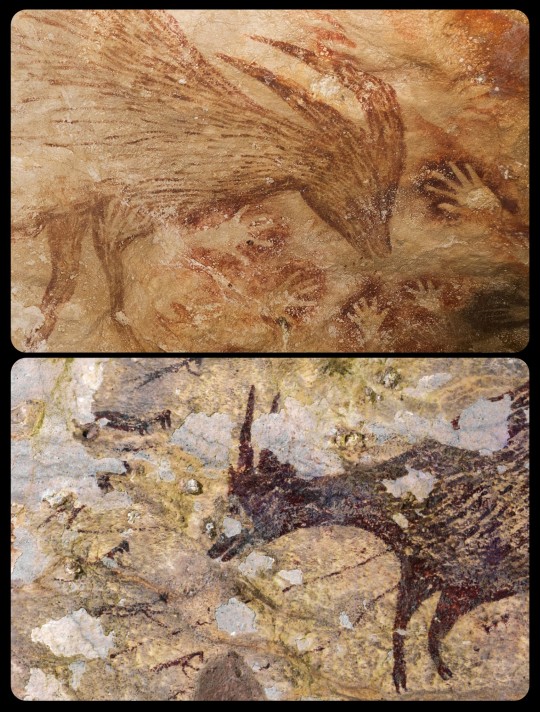
Above: anoas depicted in the cave paintings of Leang Timpuseng (top) and Leang Bulu' Sipong (bottom); the painting from Leang Bulu' Sipong dates back to at least 48,000 years ago, making it the second-oldest figurative painting in the world
Archaeologists have been aware of Sulawesi's cave art since the 1950's, but dating techniques were not used on the paintings until 2014. For decades, it was assumed that the artwork was less than 10,000 years old, but when animal paintings and hand stencils from seven different caves were finally analyzed in 2014, researchers were shocked to discover that some of the artwork was created more than 39,000 years ago. Since then, archaeologists have discovered and/or dated many other cave paintings from Sulawesi (and some from the neighboring island of Borneo) that date back to between 35,000 and 51,200 years ago.

Above: the painting from Leang Tedongnge
When this particular painting was discovered in 2017, it briefly qualified as the world's oldest example of figurative art and the oldest known depiction of an animal, but it has since been surpassed by two other cave paintings from other sites in Sulawesi. This is still the third-oldest figurative painting in the world.
These discoveries firmly contradict the traditional (and deeply eurocentric) assumptions that were once made regarding the origins of artistic expression, as this article explains:
Previously, the oldest known cave art was thought to have first appeared in Europe 40,000 years ago, showcasing abstract symbols. By 35,000 years ago, the art became more sophisticated, showing horses and other animals.
These latest finds in Indonesia have challenged a long-standing belief that artistic expression – and the cognitive leap that may have accompanied it – began in Europe.
It’s now thought that the capability to create figurative art either emerged before Homo sapiens migrated out of Africa and headed for Europe and Asia more than 60,000 years ago, or that it emerged more than once as humans spread around the globe.
And this article adds:
The geographic location of the painting is significant. Although experts have long recognized that humans originated in Africa, “Europe was once thought of as a ‘finishing school’ for humanity,” says archaeologist April Nowell of the University of Victoria in Canada, because all the oldest known examples of art and other sophisticated behaviors were found there. But in reality, the pattern of discoveries just reflected the disproportionate amount of archaeological research that was being carried out in Europe, especially in France.
“This new discovery adds to an already rich record of early and varied rock art from [Indonesia and Australia] and underscores the importance of conducting research outside Europe,” Nowell says.
Unfortunately, many of the cave paintings in Sulawesi and other parts of Indonesia are now rapidly crumbling away as a result of climate change. The limestone surfaces of the cave walls are peeling away at an alarming rate, erasing large sections of the paintings in the process; in some caves, patches of artwork measuring 2-3cm wide vanish every few months.
Sources & More Info:
Science Advances: Oldest Cave Art Found in Sulawesi
CNN: A Warty Pig Painted on a Cave Wall 45,500 Years Ago is the World's Oldest Depiction of an Animal
Smithsonian Magazine: A Journey to the Oldest Cave Paintings in the World
Nature: Narrative Cave Art in Indonesia by 51,200 Years Ago
Nature: Pleistocene Cave Art from Sulawesi, Indonesia
Art Net: Archaeologists Have Discovered a Pristine 45,000-Year-Old Cave Painting of a Pig that May be the Oldest Artwork in the World
Art Net: Some of the Oldest and Most Revered Cave Paintings in the World Are Under Extreme Threat Due to Climate Change
#archaeology#artifact#history#anthropology#prehistoric art#cave painting#warty pig#leang tedongnge#sulawesi#indonesia#art#painting#eurocentrism#conservation#art history#pigs#hand stencils#pleistocene#all hail the warty pig
358 notes
·
View notes
Text

North Sulawesi babirusa Babyrousa celebensis
Observed by roylesafaris, CC BY-NC
93 notes
·
View notes
Text

“Fake news!”
Animal: Sulawesi macaque. Location of shot: Sulawesi.
“Sulawesi macaque reading news.”
by Matti Rauvala (Finland)
2023 Comedy Wildlife Photography Awards
#matti rauvala#photographer#finland#comedy wildlife photography awards#sulawesi macaque#macaque#animal#mammal#wildlife#sulawesi#nature
52 notes
·
View notes
Text

Horse cart along the Beach of Amurang, Sulawesi island, Indonesia
Indonesian vintage postcard
#postkaart#photo#postcard#Amurang#photography#postal#island#Horse#Sulawesi#sepia#postkarte#Indonesia#briefkaart#vintage#carte postale#Beach#along#ansichtskarte#cart#ephemera#historic#tarjeta#Indonesian
13 notes
·
View notes
Text
Mount Latimojong is the highest mountain in Sulawesi Island. Its peak is at an altitude of 3,478 meters above sea level...
10 notes
·
View notes
Text
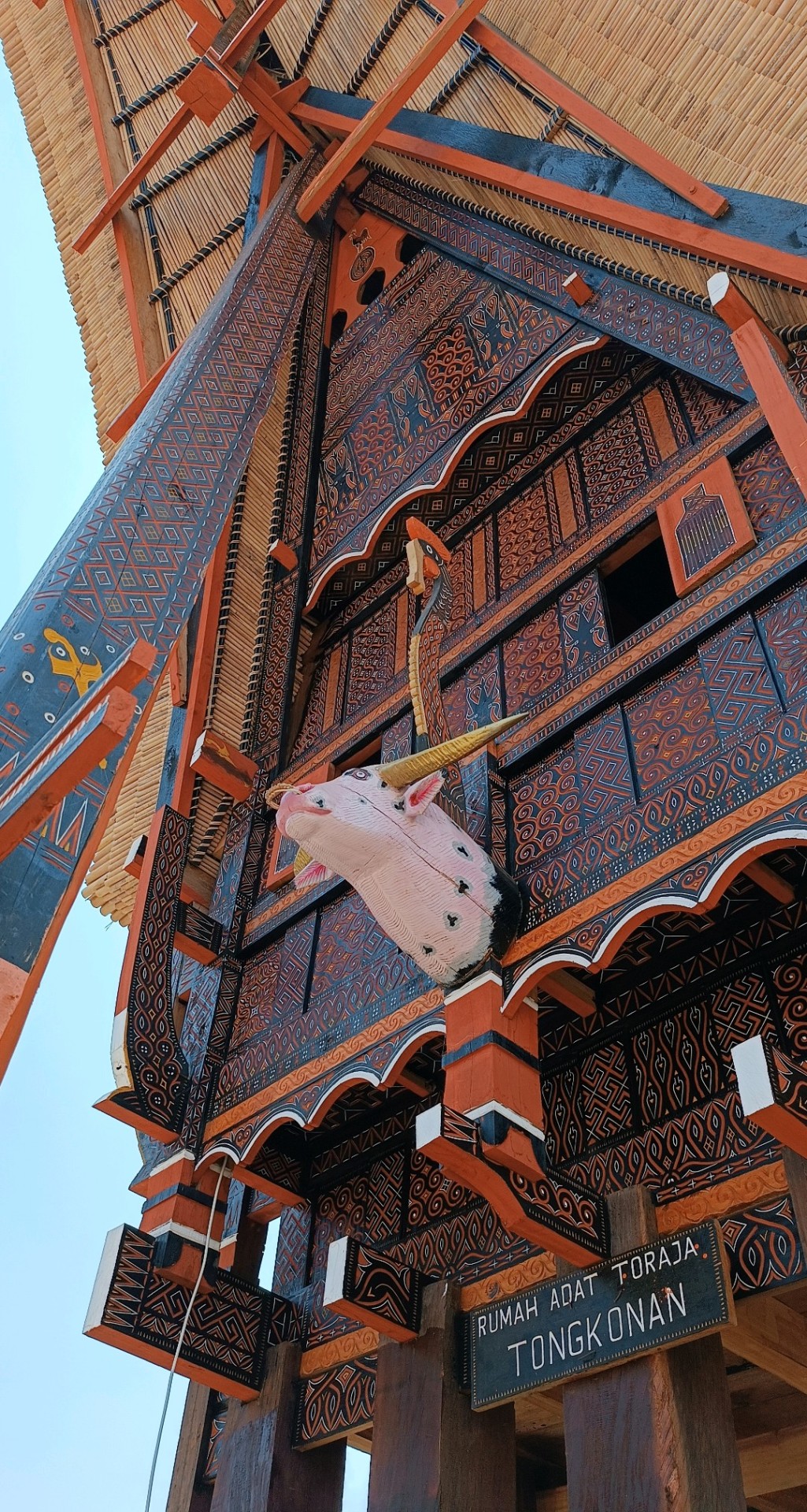
Toraja tribe house "tongkonan" in Center Point Indonesia (CPI), Makassar, Indonesia.
59 notes
·
View notes
Text

#IFTTT#Flickr#thesulawesicommander#moduzalymirelymire#nymphalidae#limenitidinae#palu#sigi#sulawesi#indomesia#butterflies#lepidoptera
8 notes
·
View notes
Text



A fishermen's town
10 notes
·
View notes
Text

This is the Paucidentomys vermidax, the edented Sulawesi rat. It lives in remote rainforest areas on the Indonesian island that is part of its name. It is the only rodent without molars, which it doesn't need because its diet is likely entirely made up of soft, easy to chew earthworms.
Discovered only in 2012, it is one of the most recent species of rodent (and mammal) to be described.
28 notes
·
View notes
Text
The changing scenes from sunset to evening skies above Kilo 5 Beach, Banggai, Indonesia.



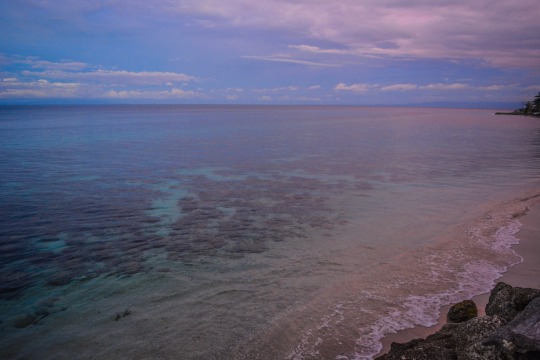




9 notes
·
View notes
Text
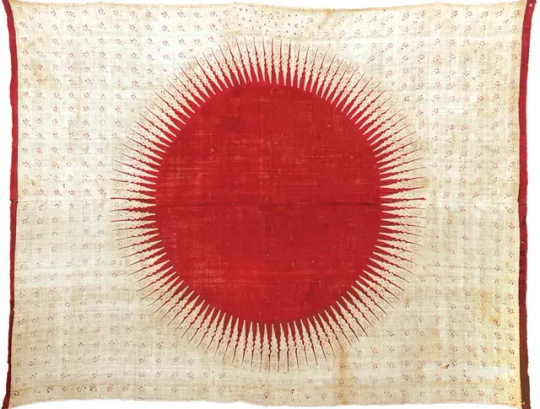
'Mata Hari' ceremonial cloth (C18th/19th)
Made on the Coromandel Coast, India for the Indonesian market and found in Sulawesi, Indonesia
A ceremonial cloth bearing a radiating red sun or eye-of-the-day. Chintz, hand-painted centre, printed outer decoration: resist and mordant-dyed on cotton 2.7 x 2.04m
Karun Thakar Collection
8 notes
·
View notes
Text
48,000-Year-Old Cave Painting from Indonesia: this painting shows several animals being hunted by tiny figures that are part-human and part-animal (known as therianthropes); researchers believe that this may be the earliest known depiction of mythical beings
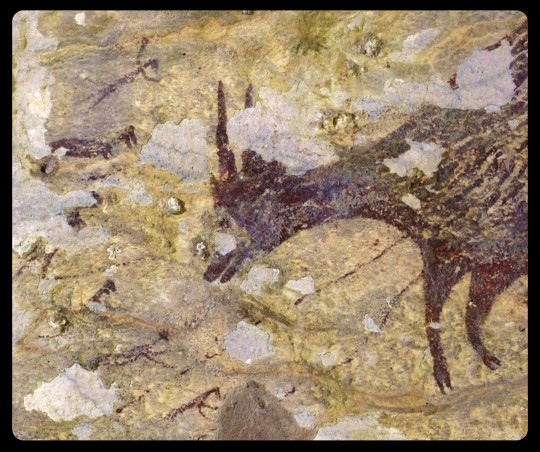
This painting was found at Leang Bulu' Sipong 4, which is a limestone cave located on the island of Sulawesi, in Indonesia.

The panel shown here is just one part of a much larger painting that measures nearly 4.5 meters (about 15 feet) long, and it decorates the wall of a hidden chamber that was discovered back in 2017. The full-length painting portrays six animals, including two wild pigs and four anoas (which are small, buffalo-like creatures that are endemic to Indonesia). All of the animals are shown being captured, hunted, and/or pursued by tiny figures that appear to be part-human and part-animal; their vaguely human-like bodies are depicted with animalistic features such as tails, beaks, muzzles/snouts, lizard-like torsos, and horns.

Above: a digital tracing of the full-sized painting, with one of the anoas and several human-like figures magnified
It's possible that some of these animal-like traits represent masks, headdresses, or costumes, but several of the figures also exhibit more extreme features that cannot be produced by simple costumes. Researchers argue that the animal-like costumes would also be useless and impractical as hunting props, given that they mostly seem to mimic small animals like birds and lizards.
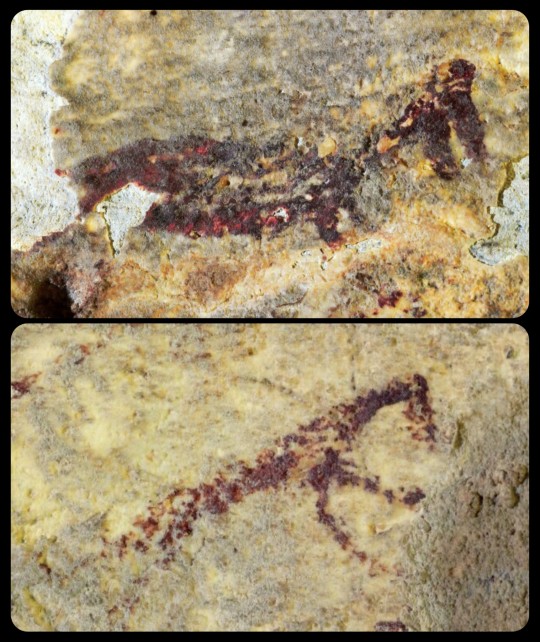
Above: two of the figures that are described as therianthropes, both of which seem to be using spears or ropes to subdue the much larger anoa
The original analysis of this painting in 2019 indicated that it was created over 43,900 years ago, but further testing in 2024 revealed that it was created even earlier, dating back to at least 48,000 years ago -- which makes this the world's second-oldest example of figurative art (i.e. artwork that depicts real or recognizable subjects, such as humans or animals).
It's unclear whether or not the animal-like figures actually represent therianthropes, but if they are therianthropic, as archaeologists speculate, then this painting would be the world's oldest known depiction of mythical beings, and it would constitute the earliest known evidence of spiritual or supernatural thinking. It is more than 8,000 years older than the famous Löwenmensch ("lion-man") carving from Germany, which has long been recognized as the world's oldest depiction of a therianthrope.
According to this article:
For whoever painted these figures, they represented much more than ordinary human hunters. One appears to have a large beak while another has an appendage resembling a tail. In the language of archaeology, these are therianthropes, or characters that embody a mix of human and animal characteristics.
"The images of therianthropes may also represent the earliest evidence for our capacity to conceive of things that do not exist in the natural world, a basic concept that underpins modern religion,” said Adam Brumm, study co-author and associate professor at the Australian Research Centre for Human Evolution. “Therianthropes occur in the folklore or narrative fiction of almost every modern society, and they are perceived as gods, spirits or ancestral beings in many religions worldwide.”
These interpretations are speculative, however, and the inspiration for the painting, as well as its significance to the humans who created it, is likely to remain a mystery.
Archaeologists have been aware of Sulawesi's abundant cave art since the 1950's, but dating techniques were not used on the paintings until 2014. For decades, it was assumed that the artwork was less than 10,000 years old, but when animal paintings and hand stencils from seven different caves were finally analyzed in 2014, researchers were shocked to discover that some of the artwork was created more than 39,900 years ago -- predating most of the world's earliest known cave paintings. Since then, archaeologists have discovered and/or dated many other cave paintings from Sulawesi that date back to more than 40,000 to 51,200 years ago.
These discoveries firmly contradict the traditional (and deeply eurocentric) assumptions that had previously been made about the origins of artistic expression, as this article explains:
Previously, the oldest known cave art was thought to have first appeared in Europe 40,000 years ago, showcasing abstract symbols. By 35,000 years ago, the art became more sophisticated, showing horses and other animals.
These latest finds in Indonesia have challenged a long-standing belief that artistic expression – and the cognitive leap that may have accompanied it – began in Europe.
It’s now thought that the capability to create figurative art either emerged before Homo sapiens migrated out of Africa and headed for Europe and Asia more than 60,000 years ago, or that it emerged more than once as humans spread around the globe.
Unfortunately, many of the cave paintings in Sulawesi and other parts of Indonesia are now rapidly crumbling away as a result of climate change. The limestone surfaces of the cave walls are peeling away at an alarming rate, erasing large sections of the paintings in the process; in some caves, patches of artwork measuring 2-3cm wide are vanishing every few months.
Sources & More Info:
The Guardian: Earliest Known Cave Art by Modern Humans Found in Indonesia
Scientific American: Is This Indonesian Cave Painting the Earliest Portrayal of a Mythical Story?
National Geographic: Ancient Cave Art May Depict the World's Oldest Hunting Scene
The Leakey Foundation: Indonesian Cave Paintings Show the Dawn of Imaginative Art
Nature: Earliest Hunting Scene in Prehistoric Art
Nature: Narrative Cave Art in Indonesia by 51,200 Years Ago
The New York Times: Mythical Beings May be Earliest Imaginative Cave Art by Humans
Science: World's Oldest Hunting Scene Shows Half-Human, Half-Animal Figures -- and a Sophisticated Imagination
Smithsonian Magazine: A Journey to the Oldest Cave Paintings in the World
Art Net: Some of the Oldest and Most Revered Cave Paintings in the World Are Under Extreme Threat Due to Climate Change
Nature: Humanity's Oldest Art is Flaking Away
#archaeology#artifact#history#anthropology#cave painting#prehistoric art#sulawesi#indonesia#leang bulu sipong#art#painting#therianthropes#mythology#spirituality#folklore#humanity#mythical figures#or just weird looking art#probably a little bit of both
119 notes
·
View notes
Text

North Sulawesi babirusa Babyrousa celebensis
Observed by bertharris, CC BY-NC
109 notes
·
View notes
Text
Shrimp Tournament: THE FINAL POLL
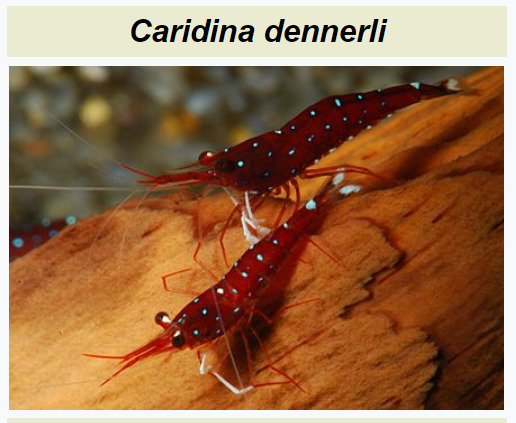
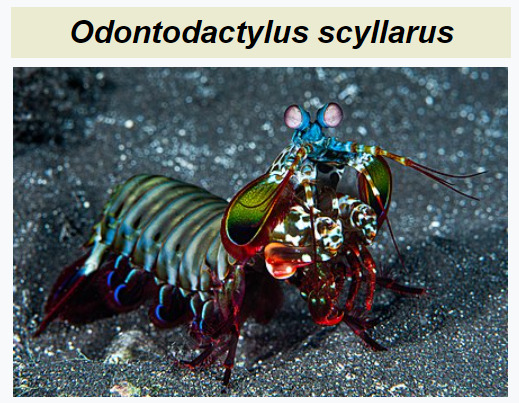
#shrimp tournament#freshwater shrimp#saltwater shrimp#shrimpblr#polls#fishblr#sulawesi#Sulawesi shrimp#peacock mantis shrimp
45 notes
·
View notes
Text

Port of Makassar, South Sulawesi, Indonesia
Dutch vintage postcard
#South#sepia#Sulawesi#historic#Dutch#ansichtskarte#Indonesia#briefkaart#Makassar#Port#vintage#carte postale#postcard#postkaart#tarjeta#photography#postkarte#photo#ephemera#postal
9 notes
·
View notes